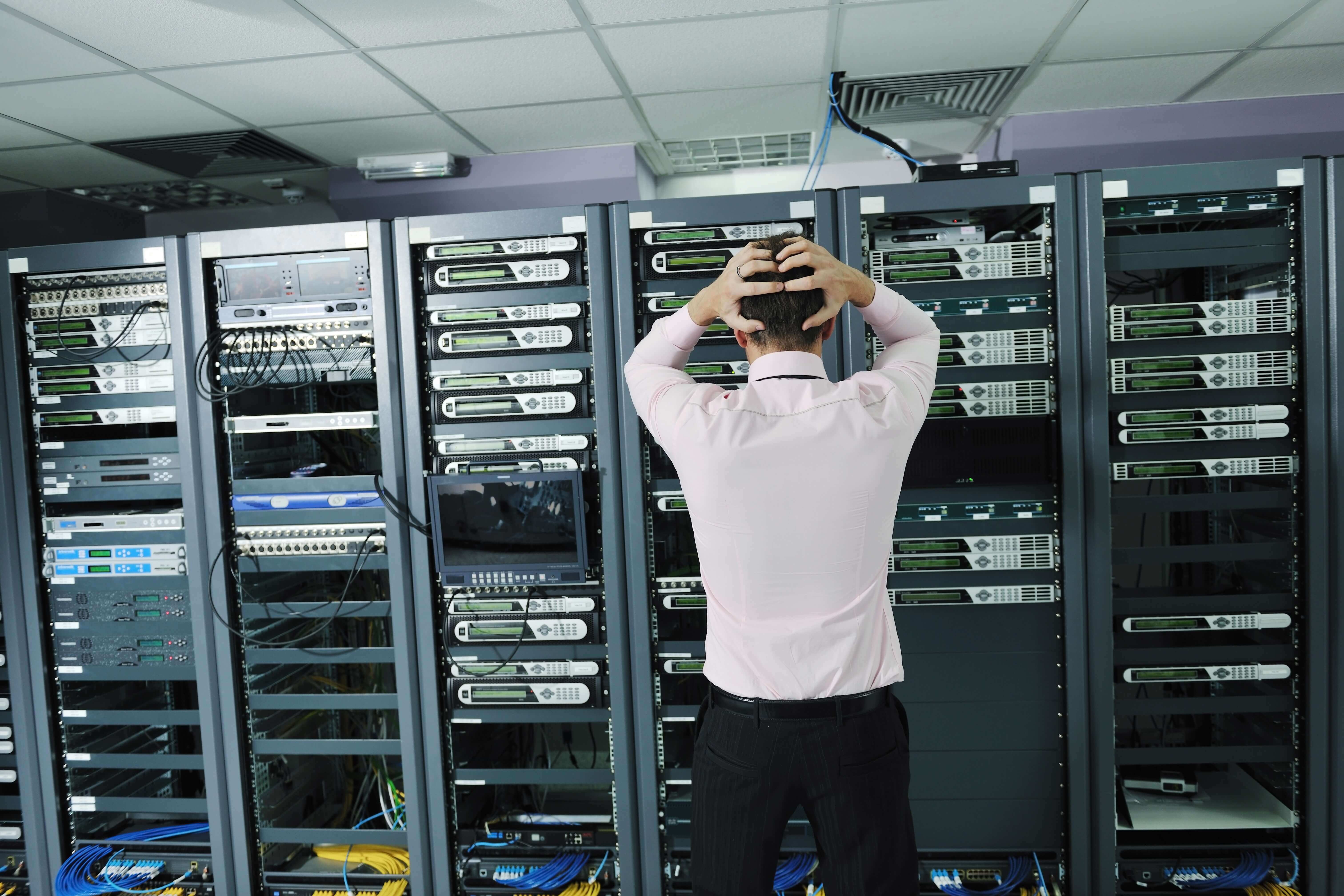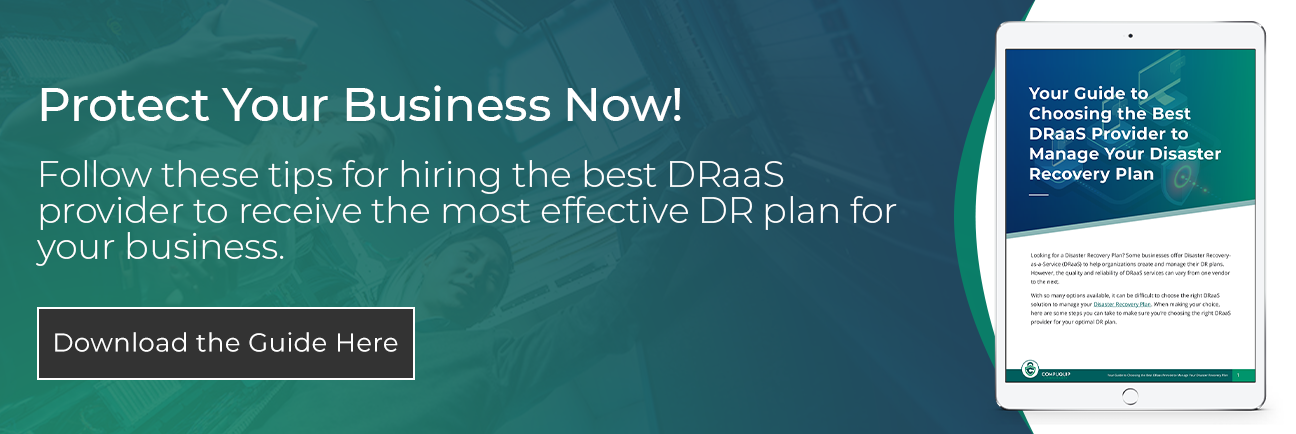5 FAQs about DRaaS (+ How It Supports Enterprise Growth)
As the frequency and intensity of natural disasters and cyberattacks increases each year, it’s increasingly important to have a disaster recovery plan in place for your enterprise. Your company’s data needs to be protected from a significant event that might cause damage, but where do you start when putting a disaster recovery plan together?
Some cybersecurity organizations actually offer disaster recovery as a service to fortify your enterprise’s future and data. What does that mean, though? Let’s dig into that question, and more.
Quick Links:
- What is Disaster Recovery as a Service (DRaaS)?
- Costs of Disaster Recovery Services and Downtime
- Backup as a Service (BaaS) vs. Disaster Recovery as a Service (DRaaS)
- 3 DRaaS Operating Models
- Frequently Asked Questions about DRaaS
What is Disaster Recovery as a Service (DRaaS)?
Disaster recovery as a service (DRaaS) is a cloud computing service model that allows an organization to back up its data and IT infrastructure in a third-party cloud computing environment that provides all the DR orchestration.
The as-a-service model means that the organization itself doesn’t have to own all the resources or handle all the management for disaster recovery, and instead relies on the service provider.
Costs of Disaster Recovery Services and Downtime
Disaster recovery is often seen as a strict cost when it should be considered an investment. It’s important to calculate the return on investment (ROI) of keeping data, systems, and applications secure.
You can get the information you need by reviewing your budget to capture costs, such as infrastructure expenses (from staff to IT hardware), and calculating revenue losses. Your costs also depend on whether you choose a self-service, assisted, or managed DRaaS solution.
Disaster recovery as a service is cost-effective. Your business can access DRaaS for a predictable, flat monthly fee. On the other hand, if you choose NOT to opt-in, your organization’s downtime could cost an average between $300k-$400k USD per hour.
Backup as a Service (BaaS) vs. Disaster Recovery as a Service (DRaaS)

With disaster recovery as a service, the service provider moves an organization’s computer processing to its cloud infrastructure in the event of a disaster. So even if the original IT infrastructure is totally destroyed or held hostage, the business can continue.
This differs from backup as a service, where only the data, but not the ability to process the data, is duplicated by a third-party provider. Because BaaS is only protecting the data and not the infrastructure, it is typically less expensive than DRaaS. BaaS can be a good solution for companies that need to archive data or records for legal reasons.
3 DRaaS Operating Models
There are three primary models available when researching options for providers who perform DRaaS:
Managed DRaaS
In a managed DRaaS model, a third-party organization assumes all responsibility for disaster recovery. Choosing this option requires an organization to stay in close contact with its DRaaS provider to ensure that it stays up to date on all infrastructure, application, and service changes. If you lack the expertise or time to manage your own disaster recovery, this may be the best option for you.
Assisted DRaaS
If you prefer to maintain responsibility for some aspects of your disaster recovery plan, or if you have unique or customized applications that might be challenging for a third-party vendor to take over, assisted DRaaS might be a better option. In this model, the service provider offers its expertise for optimizing disaster recovery procedures, but the customer is responsible for implementing some or all of the disaster recovery plan.
Self-Service DRaaS
The least expensive option is self-service DRaaS, where the customer is responsible for the planning, testing, and management of disaster recovery, in addition to hosting its own infrastructure backup on virtual machines in a remote location. Careful planning and testing are required to make sure that processing can fail over to the virtual servers instantly in the event of a disaster. This option is best for those who have experienced disaster recovery experts on staff.
Frequently Asked Questions about DRaaS

Why is Having a Disaster Recovery Plan Important?
It’s important to be prepared for any situation regarding the wellbeing of your enterprise’s data and other assets. Disaster recovery plans account for the worst-case scenario of a natural disaster sweeping through your company’s location and destroying all technical hardware.
It would be nearly impossible to fully recover from that situation without having a DR plan in place. An organization can continue to run applications – it just runs them from the service provider’s cloud or hybrid cloud environment instead of from the disaster-affected physical servers.
This means recovery time after a disaster can be much faster, or even instantaneous; with the total business cost of downtime reaching exorbitant levels, it’s imperative that your business can get back up and running.
What Are the Benefits of Using DRaaS?
Many businesses with lean IT teams simply can’t afford to take the time needed to research, implement, and fully test disaster recovery plans. DRaaS takes the burden of planning for a disaster off of the organization and puts it into the hands of experts in disaster recovery.
It can also be much more affordable than hosting your own disaster recovery infrastructure in a remote location with an IT staff standing by if disaster strikes. If a disaster doesn’t happen, then that expensive second infrastructure and staff never get used.
Who Should Have a Disaster Recovery Plan?
Every organization must be prepared for a disaster in whatever form it comes. There are countless statistics quoted as to how many businesses fail because they weren’t prepared for a disaster; whether the percentage of failed businesses is large or small, you don’t want your organization to be among the statistics.
Why Should My Enterprise Use DRaaS?
Any business that collects data needs to have a secure and well-structured disaster recovery strategy. Failure to do so not only results in massive data loss but also can also seriously damage a business’ credibility and reputation in the market. Businesses without a disaster recovery strategy put themselves at serious risk of going out of business.
However, even businesses that have disaster recovery strategies in place can often find themselves unprotected during a natural or man-made disaster because the plan was never tested or exercised. Partnering with a DRaaS provider ensures your business and its assets will be okay.
What to Consider When Finding a DRaaS Provider?
Ask yourself the following questions when considering or comparing DRaaS providers:
- Do you have the ability to customize your options? Make sure to look for cloud providers and MSPs that will work with you based on your goals and business needs and customize your application availability SLAs.
- How reliable are their services or their support? Discovering your DRaaS backup reliability is delayed 24 hours – or doesn’t work at all – is not ideal, especially when your database needs it the most. Picking the right DRaaS solution includes having the confidence and peace of mind that your provider will reliably meet or even exceed its recovery point and time objectives.
- What security measures are in place? Ask a potential managed service provider what security initiatives they have in place to protect against these concerns, such as DRaaS replication and failback. Verify that your providers encrypt your data at both at-rest and inflight as well as how they authenticate users from a virtual failover environment.
Now that you have some steps to help you find the best DRaaS provider for an optimal Disaster Recovery Plan, you can start narrowing your options and find the right backup and disaster recovery solution for your organization.
With Compuquip, you don’t need to look any further! We have extensive experience in helping companies find the right technology to fit their needs and get said tools up and running. Contact the team here at Compuquip Cybersecurity and let us worry about your data security and recovery so you can focus on running your business.

